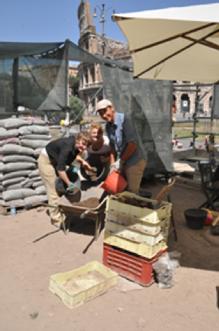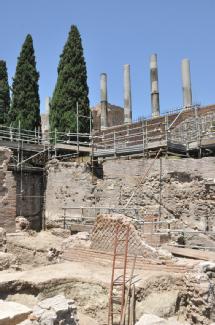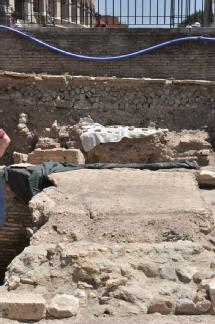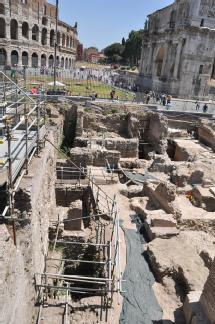Archaeological excavations
 |
|
Abigael Flack, Lois Norris and Maciej Jaszczynski at work, in the background the Colosseum. |
As a department we are happy to organise archaeological fieldwork experience for those who are interested. Once students arrive at Warwick they can contact Suzanne Frey-Kupper for placement opportunties, or respond to the emails sent from both staff and current students about opporunities throughout the year.
A snapshot of archaeological experience:
Three students of the Classics Department have been over summer on the prestigious excavation on the north-eastern slope of the Palatine in Rome directed by Professor Clementina Panella assisted by Dott. Giacomo Pardini, Università La Sapienza, Rome. The experience is all the more valuable as the Warwick students have been working with Italian students.
Suzanne Frey-Kupper who has been invited to this collaboration warmly thanks her colleagues of the Sapienza.
Here is a section of the students' report:
‘In July, after my first year of studies in Classics I had the opportunity to participate in the excavations on the north-east slope of the Palatine Hill in Rome, directed by Professor Clementina Panella from the University La Sapienza. These two weeks were my first ever excavation and it turned out to be a very valuable experience. Two other students from Warwick's Classics Department also participated in the dig, Abigael Flack and Lois Norris.
The excavated area covers about 4000 m2 and is the biggest ongoing excavation in Rome. Its aim is to reconstruct the spatial organisation of this part of the city, which was completely unknown before the project. Several very important finds have been discovered in this area: the Augustan fountain known as ‘Meta’ in the sources, a sanctuary identified as Romulus' ‘Curiae Veteres’ and the forth century A.D. insignia discovered in 2005. We worked mainly on the Neronian
and Flavian levels. While removing the soil I noticed a floor in opus signinum which turned out to be quite big, beautiful and very well preserved. Dating back to the Late Republican period it was used up to the Neronian fire in AD 64 (see below, middle).



This was a very important experience for me, even though I am a ‘classicist’ rather than an ‘archaeologist’, interested more in literature and language than in material culture. I have seen how literature and archaeology work together to identify structures and objects and how these sources complement each other. Moreover, a detailed knowledge of the area will be very useful to me, since I am studying ‘The Roman Empire from Tiberius to Hadrian’ module this year.
In addition, we had the opportunity to see how studying in Italy differs from that in UK.
I am very happy that I had such a great opportunity to experience archaeological excavations and to learn many new things working in the heart of the Roman Empire. I really enjoyed that time. I really enjoyed that time and I would like to thank my personal tutor, Dr Suzanne Frey-Kupper, for making it possible and for a few Italian lessons.’
Maciej Jaszczynski
